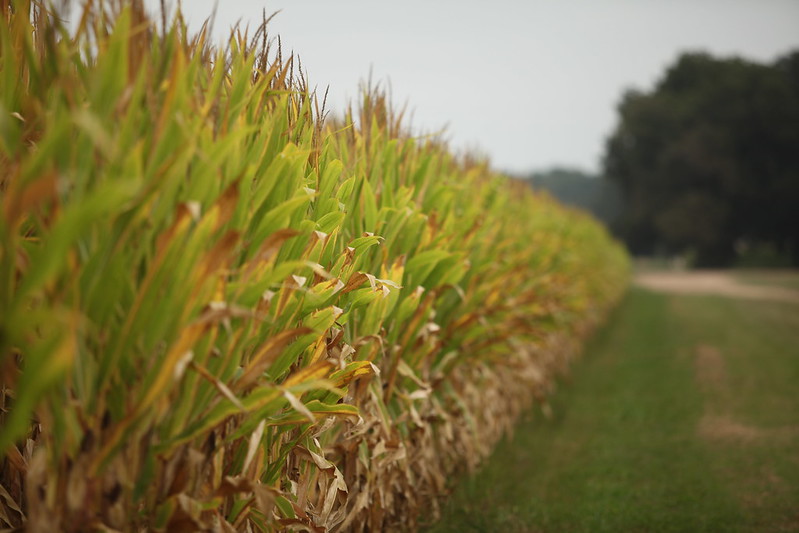After a months-long slog, Arkansas corn is finally in the ground
May 30, 2025
By Ryan McGeeney
U of A System Division of Agriculture
Fast Facts:
- About 53,000 acres of Arkansas corn replanted after early April floods
- Urea, UAN fertilizer prices rose through May
(560 words)
(Newsrooms: With file art of corn, Kelley)
LITTLE ROCK — While the wet spring of 2025 continues toward summer, nearly all of Arkansas growers’ corn is, at last, in the ground.
According to a May 26 U.S. Department of Agriculture report, the state’s growers reported that 98 percent of planned 710,000 corn acres had been planted.
Jason Kelley, extension wheat and feed grains agronomist for the University of Arkansas System Division of Agriculture, said that despite a strong early start to the season, the near-weekly periodic rainfalls across the state complicated growers’ efforts through much of the prime planting window.
“It’s been a challenging year,” Kelley said. “A lot of that corn planted in March ended up being replanted. It’s been wet in a lot of areas since April 1. We’ve had a few days here and there to get everything done.”
Of the 265,000 corn acres that had been planted in Arkansas by the end of March, approximately 53,000 acres were replanted after major rain and flooding events in early April, according to USDA.
“There’s a number of farmers who thought they were going to replant corn, who, now that we’re at the end of May, just never really got the chance and are sticking with their original suboptimal stand,” Kelley said.
According to USDA, there were 2.3 days “suitable for fieldwork” from May 18-25. Growers reported 54 percent of farm topsoil to be in a moisture surplus, along with a subsoil moisture surplus on 48 percent of acreage.
Kelley said Arkansas growers unable to replant lost corn acres in April or May will forego the crop, as the declining potential yield associated with very late planting makes the effort unprofitable.
“Our planting date studies have shown that after about May 1, yields generally start dropping off from late planting,” Kelley said. “If budgets are already tight, you’ve got to have a pretty good yield to break even — and the profitability’s going down every day once we get into May.”
Among factors impacting profitability is the high price of inputs, especially nitrogen, which typically constitutes between 33 and 44 percent of corn operating costs, according to USDA’s Economic Research Service. Prices for multiple forms of nitrogen, ranging from raw urea to the liquid UAN — urea ammonium nitrate — have not only risen steadily over the past year, but skyrocketed in May in particular.
In late March, the Economic Research Service published a report noting that the prices of both urea and anhydrous ammonia, while lower than the astronomical peaks seen in 2022 and 2023, were still at elevated, if stable levels. DTN, which tracks trade information for agriculture, energy and other sectors, reported an average price of $652 a ton as of May 28, marking a 13 percent increase over April prices. Two common formulations of UAN — UAN28 and UAN32 — averaged $414 a ton and $494 a ton, respectively.
Kelley said that while the liquid formulations of the fertilizer are sometimes less expensive, the stop-and-start nature of a rainy planting season likely pushes growers to favor the dry options for quicker application.
“The liquid application rigs take time, and it takes manpower to run the tractor,” he said. “In years like this, when we get pushed to hurry up and get something done between the rains, most people go with urea. It’s simpler to put out, and you can cover a lot more acreage in a shorter period.”
To learn about extension programs in Arkansas, contact your local Cooperative Extension Service agent or visit www.uaex.uada.edu. Follow us on X and Instagram at @AR_Extension. To learn more about Division of Agriculture research, visit the Arkansas Agricultural Experiment Station website: https://aaes.uada.edu/. Follow on X at @ArkAgResearch. To learn more about the Division of Agriculture, visit https://uada.edu/. Follow us on X at @AgInArk.
About the Division of Agriculture
The University of Arkansas System Division of Agriculture’s mission is to strengthen agriculture, communities, and families by connecting trusted research to the adoption of best practices. Through the Agricultural Experiment Station and the Cooperative Extension Service, the Division of Agriculture conducts research and extension work within the nation’s historic land grant education system.
The Division of Agriculture is one of 20 entities within the University of Arkansas System. It has offices in all 75 counties in Arkansas and faculty on three campuses.
Pursuant to 7 CFR § 15.3, the University of Arkansas System Division of Agriculture offers all its Extension and Research programs and services (including employment) without regard to race, color, sex, national origin, religion, age, disability, marital or veteran status, genetic information, sexual preference, pregnancy or any other legally protected status, and is an equal opportunity institution.
# # #
Media Contact:
Ryan McGeeney
rmcgeeney@uada.edu
@Ryan_McG44
501-671-2120
